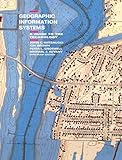Geographic information systems a guide to the technology John C. Antenucci, Kay Brown, Peter L. Croswell, Michael J. Kevany with Hugh Archer
Tipo de material: Libro
impreso(a)
Idioma: Inglés Detalles de publicación: New York Van Nostrand Reinhold 1991Descripción: xiii, 301 páginas fotografías, ilustraciones, mapas 28 centímetrosISBN:
Libro
impreso(a)
Idioma: Inglés Detalles de publicación: New York Van Nostrand Reinhold 1991Descripción: xiii, 301 páginas fotografías, ilustraciones, mapas 28 centímetrosISBN: - 0442007566
- 9780442007560
- 9781461367550
- 910.285 G4
Incluye bibliografía e índice: páginas 293-301
Preface.. Acknowledgments Part I Technology for the Information Age.. Chapter 1 Introduction.. Key Terms.. Capabilities.. Relevant Technologies.. Computer Science.. Information Management.. Cartography.. Geodesy, Photogrammetry, and Remote Sensing.. Data Communications.. Issues.. Technical Issues.. Institutional Issues.. Summary.. Chapter 2 Evolution of the Technology.. Origin of Geographic Information Systems.. Very Early Users.. Universities.. Role of Federal Government.. Technologies.. Growth of the Technology.. Environmental Concerns.. Awareness of Systems.. Technologies and Vendors.. Early Users.. Federal Users in the 1970s.. Role of Professional Organizations.. The Technology Matures.. Technologies.. Users.. International Developments.. Universities.. Chapter 3 Applications.. Government Applications.. Federal Government.. State Government.. Local Government.. Utility Applications.. Mature Utility Systems.. Developing Utility Systems.. Private Industry Applications.. Oil and Gas.. Forestry.. Transportation.. Marketing and Sales.. Real Estate.. Chapter 4 Benefits and Costs.. Benefits.. Benefit Types.. Type 1 Benefits.. Type 2 Benefits.. Type 3 Benefits.. Type 4 Benefits.. Type 5 Benefits.. Costs.. Cost Model.. Capital and Operating Costs.. Data Base.. Hardware and Software.. Personnel.. Financing.. Intangibles.. Benefit-Cost Analysis.. Techniques.. Part II System Components.. Chapter 5 Data Base Concepts.. Graphic and Nongraphic Data.. Graphic Data.. Nongraphic Data.. Relationships of Graphic and Nongraphic Data.. Data Management.. Approaches.. Graphic Data Storage.. Topology.. Data Directory.. Data Base Administration.. Data Quality.. Measures of Quality.. Map Scale.. Data Base Development.. Source Preparation.. Data Entry.. Quality Control.. Data Base Maintenance.. Chapter 6 Data Types.. Control Framework.. Planimetric Features.. Topographic Features.. Cadastral Features.. Legal Aspects
Developing the Digital Cadastral Layer.. Annotation.. Parcel Identification.. Parcel Attributes.. Area Boundary Features.. Conversion to Digital Form.. Facilities Features.. Natural Features.. Chapter 7 Hardware.. Hardware Components.. The Central Processing Unit.. Auxiliary Storage Devices.. Input/Output Peripheral Devices.. Computer System Operation and Performance.. Operating Systems.. Characteristics and Trends of Computer Processing Units.. Trends in Processing Unit Architecture.. Multiuser Processing Units.. Microcomputers.. High-Performance Workstations.. The Future of Computer Processing Units.. Technology and Trends in Auxiliary Storage Devices.. Tape Drives.. Disk Drives.. The Role and Function of Input/Output Peripheral Devices.. Historical Setting.. Data Entry, Edit, and Query Devices.. Hard-Copy Output Devices.. Special Purpose Devices in GIS Configurations.. Communication Hardware Devices.. Modems.. Multiplexors.. Digital Service Units.. Device Servers.. Conclusion.. Chapter 8 Geographic Information System Software.. Layers of Software.. Lower-Level Software.. Operating Systems.. Special System Utilities and Support Programs.. Geographic Information System Application Software.. Graphic Processing Capabilities.. Database Management.. Basic Cartographic and Geographic Analysis Utilities.. Special Application Software and Application Development Tools.. Special Application Software.. User Command Interfaces.. Command Languages.. Menu-Driven Commands.. Macro Programming.. Commercially Available Geographic Data Management Software.. Chapter 9 System Configurations and Data Communications.. Computer Network Concepts.. Speed and Distance Concepts.. Analog Versus Digital Communication.. Digital Transmission Modes.. Speed and Distance Considerations.. Local Communications.. Remote Communications.. Wide Area Networks.. Network Topologies and Protocols.. Computer System Configurations
Centralized Versus Distributed Systems.. Advantages and Limitations of Centralized and Distributed Approaches.. Managing a Computer Network.. Resource Sharing and Data Exchange Between Computer Systems.. Geographic Analysis in a Multivendor System Environment.. Types of Data Exchange.. The Growth of Communication Standards.. Designing a System Configuration.. The Conceptual Design.. System Configuration Profiles.. Part III Managing Change.. Chapter 10 Implementation.. Gis Design Philosophy.. Gaining and Maintaining Support.. Implementation Methodologies.. Concept.. Design.. Development.. Operation.. Audit.. Elements of Success.. Chapter 11 Legal Issues.. The Value of Information.. The Information Industry.. Information Economics.. Government's Role in Information Dissemination.. Open-Records Law and GIS Access.. Federal Information Dissemination.. State and Local Information Dissemination.. Strategies for Change.. Policy Responses.. Two Disparate Solutions.. Defining System Access.. Functional Access.. Data Base Access.. Support Access.. Mode of Funding Access.. User Fees.. Collateral Issues.. Proprietary Authority.. Privacy.. Liability for GIS Products/Services.. User Fees, Antitrust Law, and Undue Competition.. Equal Treatment.. Copyright, Contracts, and Control of Proprietary Interest.. Chapter 12 Horizons.. Perspective on the Status of the Technology.. Software and Data Structure Trend.. Graphic Data Structures.. Nongraphic Database Management and Manipulation.. Hypermedia.. Expert Systems, Artificial Intelligence, and Object-Oriented Approach.. Computer Hardware Trends.. The Desktop Revolution.. Advances in Computer Processor Performance.. Mass Storage Technology.. Graphic Display and Hard-Copy Output.. Communications and Networking.. System Planning in a Dynamic Environment.. Glossary.. Index
Geographic Information Systems: A Guide to cessing, spreadsheets, and data base the Technology was born of need-the need management. Recently, geographic infor for a comprehensive work on the emerg mation management technology came to ing field of geographic information man the desktop, signaling a new era of in agement technology. creasing use and popularity. Enthusiastic We encountered the need often in our users have long been the main source of work at PlanGraphics, Inc. , a leading com grassroots support and growth. We perceive at least three broad audi puter consulting firm that specializes in ences for this book: 1) executives, man the design and implementation of geo agers, professionals, and other lay people; graphic information systems (GIS) and as 2) practitioners and technicians; and 3) stu sists organizations in using the technology to solve problems and perform work more dents and academicians. We recognize efficiently. We needed it, our clients that Geographic Information Systems cannot needed it, and it didn't exist. completely satisfy the disparate needs of Geographic information management any of these groups, but we have tried to give each of these audiences a foundation technology-using computers to map, draw, store, and manipulate spatial data upon which to build. Our purpose is two fold. We hope to aid those considering, evolved independently in many places with many variations. Inglés


